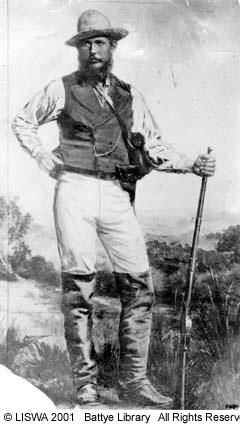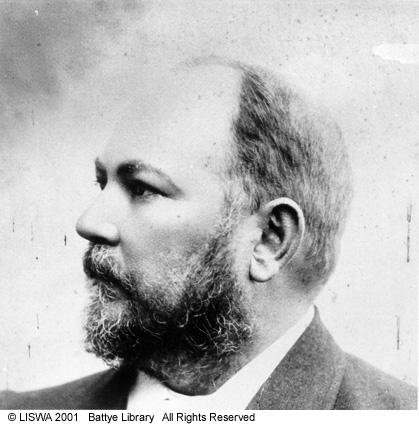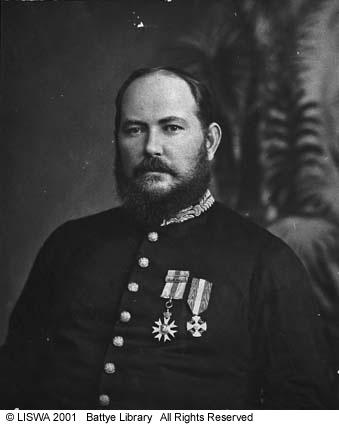|
|
|||
|
|
|
|
|
|
|
|||
JOHN FORREST1847 - 1918
|
|
|
|
|
John was born to Scottish parents (William and Margaret) who immigrated to Western Australia in 1842 aboard the ship Trusty.
|
|
John was born on the 22nd of August 1847 and although he had eight brothers (his one sister died before John was born) John was to have no children of his own.
|
|
|
By 1874, Forrest had led three highly successful expeditions across Australia. The first (1869) ended near the present site of Laverton. The second (1870) backtracked
Edward Eyre's footsteps from Western Australia, along the south coast to Adelaide.
The last (1874) left Geraldton and crossed the arid centre to the Adelaide-Darwin telegraph line and then south to Adelaide.
|
|
|
Later the same year Forrest was most unwell and boarded the troop ship Marathon on route England to seek medical treatment. He was advised by his doctor not to go but the pragmatic
explorer and statesman simply said:
|
|
|
Chronology
1847 - Born August 2nd. 1860 - Attended Bishop Hale's school in Perth until 1863. 1863 - Indentured land surveyor Thomas Campbell Carey. 1865 - Became a temporary government surveyor. 1869 - Led an expedition to try and find out what had happened to the missing explorer Leichardt. 1870 - Backtracked Edward Eyre's footsteps from Western Australia, along the south coast to Adelaide. 1871 - Appointed surveyor for the northern district. 1874 - Led an expedition from Geraldton to the Adelaide-Darwin telegraph line and then south to Adelaide. 1875 - Went to England and published the journal of his travels called 'Explorations in Australia '. Given a grant of 5000 acres of land for his efforts. 1876 - Appointed as Deputy Surveyor-General, received the founder's gold medal of the Royal Geographical Society and on February 29th he married Margaret Hamersley. (2) 1878 - Served as acting surveyor-general and commissioner of Crown lands. 1880 - Became acting Superintendent of Convicts in May. 1882 - Awarded the CMG. 1883 - Became the first native born Western Australian to be appointed to the Executive Council. 1883 - Accompanied an exploration to the Kimberley for several months. 1886 - Visited the newly opened gold-field in the Kimberley. 1887 - Visited London to represent the colony at the first Colonial Conference. 1890 - Elected unopposed as member for the Legislative Assembly electorate of Bunbury. In December he was sworn in as colonial treasurer. 1891 - Awarded a K.C.M.G. in May. 1894 - Became colonial secretary until April 1898a and won the Legislative Assembly election. 1897 - Won the Legislative Assembly election again. 1901 - Elected unopposed to the electorate of Swan in the House of Representatives. Acted as postmaster-general and minster for defence and awarded a G.C.M.G. 1903 - Minister for home affairs. 1905 - Treasurer in five governments 1905-07, 1909-10, 1913-14, 1917-18, 1918. 1918 - Resigned from the ministry due to ill health in March. 1918 - July 3rd, left Albany with his wife and a nurse aboard the troopship Marathon, headed for London with A.I.F. reinforcements. 1918 - Celebrated his 71st birthday on board. 1918 - Died on September 3rd before reaching England.
(1) - Margaret Elvire Hamersley was born at Le Harve, France, on October 22nd 1844.
Links to more information:
|
|
|
Become a supporter of this website for just $5 a month
|




